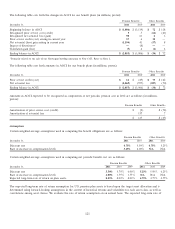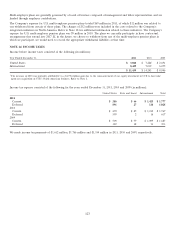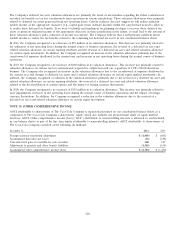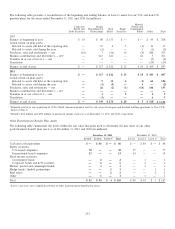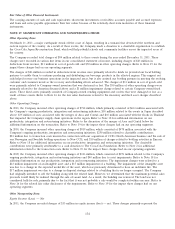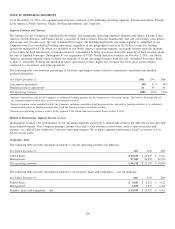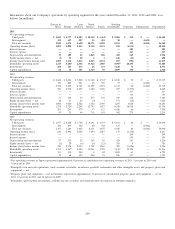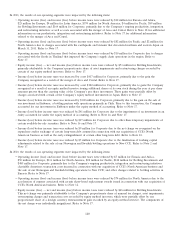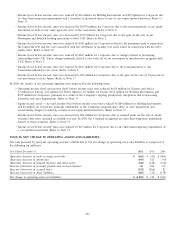Coca Cola 2011 Annual Report Download - page 133
Download and view the complete annual report
Please find page 133 of the 2011 Coca Cola annual report below. You can navigate through the pages in the report by either clicking on the pages listed below, or by using the keyword search tool below to find specific information within the annual report.
Gross realized and unrealized gains and losses on Level 3 assets and liabilities were not significant for the years ended
December 31, 2011 and 2010.
The Company recognizes transfers between levels within the hierarchy as of the beginning of the reporting period. Gross transfers
between levels within the hierarchy were not significant for the years ended December 31, 2011 and 2010.
Nonrecurring Fair Value Measurements
In addition to assets and liabilities that are recorded at fair value on a recurring basis, the Company records assets and liabilities
at fair value on a nonrecurring basis as required by accounting principles generally accepted in the United States. Generally, assets
are recorded at fair value on a nonrecurring basis as a result of impairment charges. Assets measured at fair value on a
nonrecurring basis for the years ended December 31, 2011 and 2010, are summarized below (in millions):
Gains (Losses)
December 31, 2011 2010
Exchange of investment in equity securities $ 4181$—
Valuation of shares in equity method investee 1222—
Equity method investments (41)3(15)6
Available-for-sale securities (17)4(26)7
Inventories (11)5—
Cold-drink equipment (1)5—
Investment in formerly unconsolidated subsidiary —4,9788
Retained investment in formerly consolidated subsidiary —129
Total $ 470 $ 4,949
1As a result of the merger of Arca and Contal, the Company recognized a gain on the exchange of the shares we previously owned in Contal for
shares in the newly formed entity Arca Contal. The gain represents the difference between the carrying value of the Contal shares we relinquished
and the fair value of the Arca Contal shares we received as a result of the transaction. The gain and initial carrying value of our investment were
calculated based on Level 1 inputs. Refer to Note 17.
2The Company recognized a net gain of $122 million, primarily as a result of an equity method investee issuing additional shares of its own stock at
per share amounts greater than the carrying value of the Company’s per share investment. Accordingly, the Company is required to treat this type of
transaction as if the Company sold a proportionate share of its investment in the equity method investee. The gains the Company recognized as a
result of the previous transactions were partially offset by charges associated with certain of the Company’s equity method investments in Japan. The
gains and charges were determined using Level 1 inputs. Refer to Note 17.
3The Company recognized impairment charges of $41 million related to an investment in an entity accounted for under the equity method of
accounting. Subsequent to the recognition of these impairment charges, the Company’s remaining financial exposure related to this entity is not
significant. This charge was determined using Level 3 inputs. Refer to Note 17.
4The Company recognized other-than-temporary impairment charges of $17 million on certain available-for-sale securities. The Company determined
the fair value of these securities based on Level 1 inputs. Refer to Note 17.
5These assets primarily consisted of Company-owned inventory as well as cold-drink equipment that were damaged or lost as a result of the natural
disasters in Japan on March 11, 2011. We recorded impairment charges of $11 million and $1 million related to Company-owned inventory and
cold-drink equipment, respectively. These charges were determined using Level 3 inputs based on the carrying value of the inventory and cold-drink
equipment prior to the disasters. Refer to Note 17.
6The Company recognized an other-than-temporary impairment charge of $15 million. The carrying value of the Company’s investment prior to
recognizing the impairment was $15 million. The Company determined that the fair value of the investment was zero based on Level 3 inputs. Refer
to Note 17.
7The Company recognized other-than-temporary impairment charges on certain available-for-sale securities. The aggregate carrying value of these
securities prior to recognizing the impairment charges was $131 million. The Company determined the fair value of these securities based on Level 1
and Level 2 inputs. The fair value of the Level 2 security was based on a dealer quotation. Refer to Note 17.
8The Company recognized a gain on our previously held investment in CCE, which had been accounted for under the equity method of accounting
prior to our acquisition of CCE’s North American business. Accounting principles generally accepted in the United States require the acquirer to
remeasure its previously held noncontrolling equity interest in the acquired entity to fair value as of the acquisition date and recognize any gains or
losses in earnings. The Company remeasured our equity interest in CCE based on Level 1 inputs. Refer to Note 2 and Note 17.
9The Company sold 50 percent of our investment in Le˜
ao Junior, which was a wholly owned subsidiary prior to this transaction. The gain on the
transaction consisted of two parts: (1) the difference between the consideration received and 50 percent of the carrying value of our investment and
(2) the fair value adjustment for our remaining 50 percent ownership. The gain in the table above represents the portion of the total gain related to
the remeasurement of our retained investment in Le˜
ao Junior, which was based on Level 3 inputs. Refer to Note 17 for further discussion of this
transaction.
131


